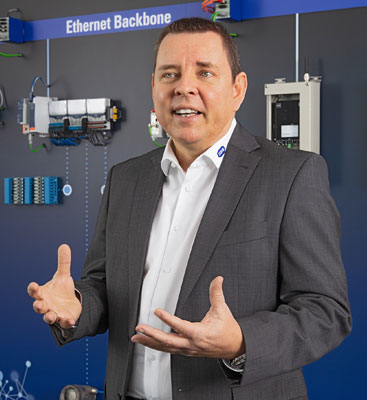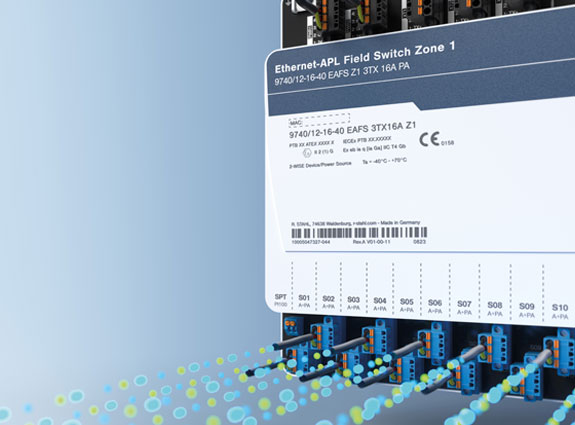Process automation is ready for the use of Ethernet up to a field level – or at least that seems to be the case to anyone keeping up to date with current reports. Manufacturers and user organisations have collaborated over the past few years to develop solutions that will make Ethernet suitable for use in the harsh everyday conditions of the process industry, and are planning to present products soon. That's when things will really get started, surely?
Statement of André Fritsch, member of the Ethernet-APL working group
"I hear the message loud and clear, but faith fails me." Looking back on the last decade, many would likely feel the same as Goethe's protagonist Faust. The demand for digital transmissiontechnology and smarter solutions is no recent phenomenon; it existed long before "Industry 4.0" was the term on everyone's lips. In 1987, R. STAHL became one of the first manufacturers to market a Remote I/O system that was suitable for installation even in Zone 1 hazardous areas and communicated using a digital fieldbus. It was heralded as a revolution – a game changer, as many called it – but it took another ten years before the concept of an "intelligent terminal box" gained ground and other manufacturers brought products to the market. In the meantime, the third generation of R. STAHL products (IS1+) has become the market leader for Remote I/O solutions in Zone 1; however, this technology is still far behind conventional 4–20 mA installation. So why should we expect anything better from new Ethernet technology? We can answer that: Because the time is right.
We have rarely seen as much activity with respect to digitalisation and digital transformation as has occurred in the past few years. Twenty years ago, most attention was on controlling processes and keeping them running. Although more and more field devices are installed in systems with HART communication, a closer look reveals that these are primarily used to enable parameters to be changed locally using a handheld device, if at all. Nevertheless – or perhaps for this exact reason – new solutions must be able to manage on the basis of this installation. A cardinal error, and one made by the 2-wire fieldbuses such as Foundation Fieldbus H1 or PROFIBUS PA. A reason why Remote I/O solutions continue to be used, sometimes even more frequently than in the past. IS1+ is one of the first systems with Ethernet connectivity, initially thanks to explosion-protected fibre optics and now also using intrinsically safe copper cables.
The development of the intrinsically safe 4-wire Ethernet 100BASE-TX-IS by the "Intrinsically Safe Ethernet" working group was finished at just the right time. It concentrates on more complex field devices, analysis decides, operating terminals, CCTV cameras and even Remote I/O systems such as IS1+. The underlying idea is to expand the widespread 100BASE-TX Ethernet according to IEEE 802.3 in order to create an intrinsically safe, standardised front end and, in doing so, make 4-wire Ethernet with data rates of up to 100 Mbit/s available as an intrinsically safe version, thereby making it fully interoperable with the industry standard. The standard electronics of devices with IEEE 802.3u-compliant MAC (Media Access Control) and 100BASE-TX PHY (Physical Layer) are maintained and expanded to include Ex i switching. 100BASE-TX-IS offers no integrated supply and can cover distances up to a maximum of 100 m using CAT cables. Supplementary corresponding 100BASE-TX-IS switches and media converters with additional FO interfaces are intended to be provided; these will enable distances as great as 30 km or even further to be bridged using single mode fibres.
The second piece of the Ethernet puzzle expands the 100BASE-TX-IS solution, while at the same time offering a new opportunity at the field device level: Ethernet Advanced Physical Layer (Ethernet-APL). Ethernet-APL is the dedicated solution for the use of Ex i 2-conductor field devices in process automation. In this regard, R. STAHL is working with eleven other manufacturers and the four standard development organisations (SDOs) for industrial communication: FieldComm Group (FCG), ODVA, OPC Foundation and PROFIBUS+PROFINET International (PI). One role of the SDOs is to ensure that Ethernet-APL is compatible with the corresponding communication protocols, i.e. that it supports HART-IP (FCG), EtherNet/IP (ODVA), OPC UA (OPC Foundation) and PROFINET (PI). This collaboration is unique in its nature and is sure to result in rapid expansion of this technology.
Ethernet-APL is based on the Physical Layer of Single Pair Ethernet (SPE) 10BASE-T1L and can bridge distances up to 1000 m at 10 Mbit/s using 2-wire conductors, while simultaneously supplying the connected devices. Ethernet-APL is compatible with most features of SPE but uses a supply concept that differs from PoDL (Power over Data Lines), in order to enable the use of the intrinsic safety type of protection. Inspired by FISCO (Fieldbus Intrinsically Safe Concept), the Ex i system concept for fieldbuses, 2-WISE (2-Wire Intrinsically Safe Ethernet) has been developed together with DEKRA EXAM and standardised in IEC TS 60079-47. This enables Ethernet-APL devices from different manufacturers to be interconnected without requiring proof of intrinsic safety, which is an unpopular task due to the work it involves. To make the migration of existing fieldbus installations as easy as possible – and to avoid repeating the error mentioned above – Ethernet-APL also uses the fieldbus type A cable in accordance with IEC 61158-2. In essence, it differs from classic fieldbuses due to Ethernet-APL's significantly higher bandwidths (10 Mbit/s compared to 31.25 kBit/s) and, most importantly, the opportunity to achieve consistent IP communication from the cloud all the way to the field.
On that note, we have not yet answered the question posed at the beginning of this article – namely, what will happen with "Ethernet in the field" in practice. It is, of course, impossible to answer this question for certain now, but the situation looks promising. The different concepts and structures taken into account within the context of digitalisation all require standardised Ethernet – or are very difficult to implement without it. Both 100BASE-TX-IS and Ethernet-APL are excellent, suitable options. In NAMUR Open Architecture (NOA), a second channel accesses additional data from the field level. This data may originate from Ethernet-APL field devices or from classic HART devices, which are integrated into the Ethernet infrastructure using Remote I/O technology and access data servers via OPC UA, for instance. In 2019, R. STAHL unveiled a prototype with the PA-DIM (Process Automation Device Information Model) as part of the NAMUR main meeting. With Ethernet in the field, users now have a technical basis that enables them to obtain usable information from the vast amounts of data in systems, and to generate real added value from it – all they have to do is get started.







![[Translate to Englisch:] [Translate to Englisch:]](/fileadmin/user_upload/mitarbeiter/01_DE/07_Blog/00_Allgemein/blog-explosionsschutz-rstahl-startseite-279x205.jpg)
![[Translate to Englisch:] [Translate to Englisch:]](/fileadmin/user_upload/mitarbeiter/01_DE/07_Blog/00_Allgemein/blog-explosionsschutz-rstahl-ueber-den-blog-279x205.jpg)
![[Translate to Englisch:] [Translate to Englisch:]](/fileadmin/user_upload/mitarbeiter/01_DE/07_Blog/00_Allgemein/blog-explosionsschutz-rstahl-autoren-279x205.jpg)
![[Translate to Englisch:] [Translate to Englisch:]](/fileadmin/user_upload/mitarbeiter/01_DE/07_Blog/00_Allgemein/blog-explosionsschutz-rstahl-newsletter-expert-mail-279x205.jpg)
Write new comment